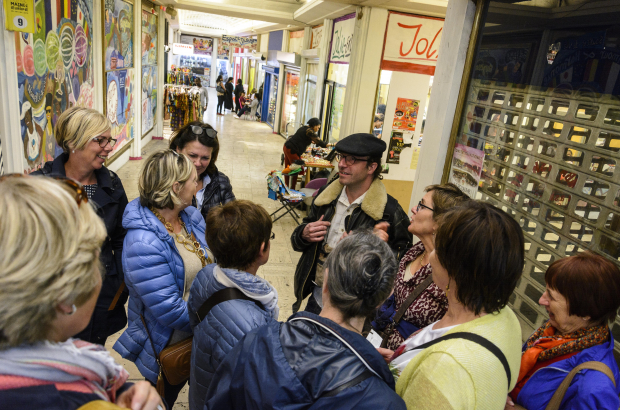- Daily & Weekly newsletters
- Buy & download The Bulletin
- Comment on our articles
Take a tour: Explore the colourful Matonge area of Brussels for an alternative view of Belgium’s colonial past and a taste of African life
Our tour kicks off just outside Matonge, amidst the towering spoils of Belgian colonisation in the city’s royal and museum quarter. A key element of the tour is addressing, or rather confronting Belgium’s colonial legacy as many Belgians remain ignorant of the atrocities committed in the Democratic Republic of Congo under the rule of Leopold II.
“We like to combine colonial history with the [walking tour] experience. It really depends how far we go, as people don’t know much about the history,” says Evelyn Cruyt from Vizit.be. “I think we do contribute to the dialogue about the colonial legacy.”
In light of the controversies - it’s estimated that between four and 14 million Congolese were killed under Leopold’s rule - many tour groups attempt to explore the history and delve into the African culture buzzing inside Matonge. The Ixelles area was established by Congolese migrants following the DRC’s independence in 1960.
“We didn’t learn much about it in school,” explains Louiza Cools, a Belgian woman taking part in the tour. “And we were only shown the positive sides” she says. “After school, we read and learned the negative side, and this tour adds to our knowledge,” added a friend of Cools.
“During our tours, there are people who do not want to confront this history - and it’s important for us to not switch them off, to keep them engaged,” explains Vizit tour guide Annekien Van Vaerenbergh.
Bram Borloo, a tour guide working for Brukselbinnenstebuiten, explained the troubled history. “There’s no clear link between what we see today and the colonial impact and traumatic past. Belgian children learn in primary school that Leopold II was the ‘King Constructor,’ which continues to construct this false image,” he says.
However, to balance the controversies with the colourfulness of the tour, Bram tries “to tell both stories - the happy one, as well.”
The main drawing point of the tour remains the uniqueness of African culture that envelops Matonge. “We hope to learn about the African way of living, to smell the atmosphere,” adds Maregke Kuigken, also taking part in the tour.
The lively district is a short walk from the EU institutions and Avenue Louise, making it a key location for the tide of gentrification tide encompassing the area. Ixelles mayor Dominique Dufourny recently pledged to “clean up Matonge,” according to local community figures, and is said to have embarked on a mammoth rehabilitation project connecting the European quarter with Avenue Louise.
Yet despite the perceived need for cleanliness, Matonge spoils visitors with an onslaught of colours, flavours and sounds. “African people all around Europe will come to Matonge, because it’s famous for its African roots,” explains Jeroen Marckelbach, the coordinator of Flemish-African cultural centre Kuumba, one of the major tour organisers in the area.
For a number of years, Kuumba has been connecting local Congolese guides to tour groups around Matonge, to immerse visitors in the epicentre of the area, while doing it thoroughly and ethically. “Some groups come here and point fingers like it’s a zoo,” recalls Jeroen.
With tours organised by Vizit, Kuumba or Brukselbinnenstebuiten, however, you’re unlikely to feel like you’re in a passing safari. “We combine our tours with tastes, and get people to engage with the local community,” explains Karel Algoed, a guide with Vizit.be. “One of the tasks is to use one of the many hairdressing salons, and also buy three ingredients for the Congolese dish Moambe,” he says.
As the tour groups - ranging from school children to retired people - move in and out of the few streets which make up Matonge, the area comes alive. From the manic clatter of shopping arcades on both sides of Chaussée de Wavre, to restaurants serving sweet peanut-sauced chicken, fish and veggie curries, and as night falls, the unique sounds of African music coming from dimmed bars, it offers a head-spinning experience.
Vizit.be and Kuumba organise more than a few dozen tours each month, available in English, Dutch or French , and are also suitable for individual groups. For day tours, the groups cover a wide range of subjects - from colonial civic buildings and controversial history, to recent statues, cultural figures and the rich history of the area. For those wanting a more immersive experience, it is possible to enroll in of the many dance, language or music classes at Kuumba.



















